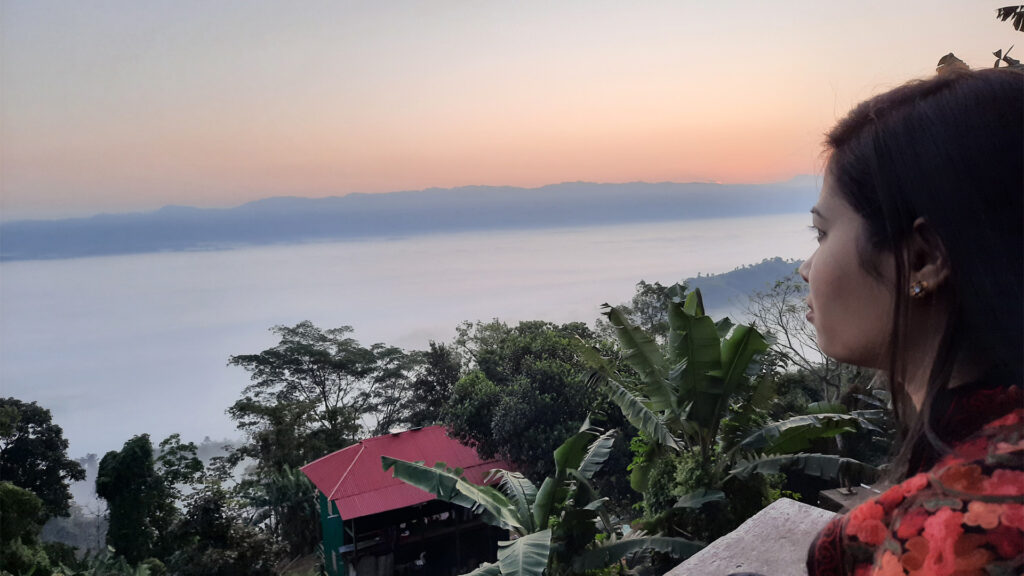Imagine losing yourself in a sea of soft, floating clouds. That’s exactly what Sajek Valley offers—a magical experience above the clouds. Nestled in Baghaichari Upazila of Rangamati, Sajek Valley has become one of the most sought-after travel destinations in Bangladesh. Although it’s part of the Rangamati district, the easiest and most popular route is through Khagrachari, thanks to its convenient location. Bordering Mizoram in India, Sajek sits 1,800 feet above sea level and is often referred to as the “Roof of Rangamati.”
Discovering Sajek Valley: The Heart of the Hills
Sajek is the largest union in Bangladesh, covering about 702 square miles. It comprises two scenic villages—Ruilui Para and Konglak Para. Ruilui Para, established in 1885, is perched at around 1,720 feet, while Konglak Para reaches up to 1,800 feet. The valley is home to indigenous communities like the Lusai, Pankhwa, and Tripura people, who add vibrant culture and warm hospitality to the natural charm of Sajek.
The valley is famous for its juicy bananas and sweet oranges. From here, you can enjoy panoramic views stretching over Rangamati, earning Sajek its nickname as the “Roof of Rangamati.”
Must-Visit Spots in Sajek Valley
1. Konglak Hill
Konglak Hill is the final village in Sajek and a highlight of any trip. From here, visitors can catch breathtaking views of the Indian Lusai Hills and even glimpse the birthplace of the Karnafuli River. The village is primarily inhabited by the Lusai community, offering an authentic cultural experience.
2. Kamalak Waterfall
Adventure lovers can trek from Ruilui Para to reach Kamalak Waterfall, also known locally as Padaam Toisha Jhorna. This scenic two-hour trek through lush greenery rewards you with the sight and sound of this serene waterfall.
3. Sunrise and Sunset Views
The sunrise from Helipad Point is a must-see. The morning clouds part to reveal the glowing sun, painting the sky in warm hues. In the evening, the sunset casts a golden glow across the valley, and when night falls, a blanket of stars adorns the sky. On clear nights, you might even spot the Milky Way.
4. Cultural Connection
While in Sajek, spend some time interacting with the indigenous communities. Their simple lifestyle and genuine hospitality create unforgettable memories. Be respectful and always ask permission before taking photos.
5. Nearby Attractions
On your way back, you can visit the Hazachara Waterfall, the Dighinala Hanging Bridge, and Dighinala Banbihar. These spots offer additional layers of adventure and beauty to your trip.
Best Time to Visit Sajek Valley
Sajek is a year-round destination, but the rainy season, autumn, and late autumn (June to November) are considered the best times to experience the clouds up close. Even in summer or winter, Sajek’s beauty is distinct and worth exploring.
How to Get to Sajek Valley
Dhaka to Khagrachari
Travelers typically start from Dhaka and head to Khagrachari by bus. Options include Saudia Paribahan, Shyamoli, S. Alam, Eagle, and Shanti Paribahan. Non-AC buses cost around BDT 520, while AC buses like BRTC or Saint Martin Paribahan range from BDT 700 to 900. Shanti Paribahan also offers direct service to Dighinala for around BDT 580. Tickets should be booked in advance, especially during holidays.
Khagrachari to Sajek
From Khagrachari, Sajek is about 70 km away. The most common transport is the “Chander Gari” (jeep), costing BDT 8,000 to 10,000 for a round trip (for groups of 12-15 people). Smaller groups can join others to share costs or use CNGs for about BDT 4,000 to 5,000, though CNGs are less suitable for the rough road.
You can also travel via Dighinala, which is 23 km from Khagrachari. From there, you can reserve motorcycles or jeeps. It’s essential to reach Dighinala before 10:00 AM to join the army escort, which is mandatory for safety on this route. Escorts leave twice a day—morning and afternoon.
Other Routes
-
From Chittagong: Buses like BRTC and Shanti Paribahan run daily to Khagrachari.
-
From Rangamati: Buses and launches travel to Baghaichhari, from where local transport can take you to Sajek.
Accommodation Options
Sajek offers a range of accommodations—from budget-friendly indigenous cottages to mid-range resorts. Popular options include:
-
Sajek Resort
-
Runmoy Resort
-
Megh Machang
-
Meghpunji Resort
-
Resort Rungrang
-
TGB Lusai Cottage
-
Affordable Indigenous Cottages
For the best experience, it’s wise to book rooms at least a month in advance, especially during peak seasons.
Dining in Sajek
Most resorts offer meals, typically costing BDT 100-200 per dish. Popular items include rice, chicken curry, and local vegetables. You can also arrange a BBQ dinner with prior notice. Indigenous households sometimes offer home-cooked meals if requested in advance. Don’t miss tasting local fruits like papaya, banana, and pineapple, which are fresh and inexpensive.
Essential Travel Tips
-
Always book your accommodation in advance.
-
Sajek has no electricity; solar power is available but limited. Bring a power bank.
-
Only Robi, Airtel, and Teletalk mobile networks work in Sajek.
-
Avoid sitting on top of jeeps for safety.
-
No tour guide is necessary.
-
Always ask permission before photographing locals.
-
Respect the culture, beliefs, and privacy of indigenous people.
-
Cooperate with army checkpoints for your safety; carry a copy of your ID card.
-
Dispose of waste responsibly to preserve Sajek’s pristine beauty.
-
Bring basic medicines and personal essentials, as shops are limited.
Perfect for Group or Family Trips
Sajek Valley is an ideal spot for group or family tours. Whether you want a quick one-day adventure or a relaxed multi-day stay, Sajek offers something for everyone—all within a budget-friendly range. If you’re looking for hassle-free arrangements, tour agencies like Travel Mate can help plan your trip.


